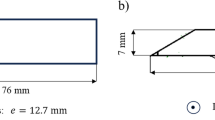Abstract
Wear is one of the most influential factors in profile grinding. The measuring of grinding wheel wear is costly and time consuming. We introduce a new online wear measuring method in a wet profile grinding for the inner ring groove of ball bearing. The advantage of this method is the reduction of electromagnetic influence of workpiece as well as the impact of grinding debris and cutting lubricant. Two pneumatic gauging probes are positioned at two different locations with the biggest gap in the wear value on the curved edge surface of the grind stone. When the compressed air flow is blown onto the working surface of the grinding wheel, the back pressure in the measuring chamber corresponding to the gap between the probe and the working surface of the grinding wheel can be measured. Therefore, the radial wear value of grinding wheel can be determined. Based on theoretical calculations and the establishment of its dynamic characteristic curve, it is demonstrated that the first probe measuring wear at the top of the curved edge surface of the grinding wheel with the parameters of the probe d1 = 0.85; d2 = 1.5; P = 4 Bar has a measurement range of 200 μm, a maximum speed ratio of 0.01 Bar/μm. The second probe used to capture wear at the margin of the curved edge surface of the grinding stone with the parameters of the probe d1 = 0.65; d2 = 1.6; P = 4 Bar has a measurement range of 140 μm, a maximum speed ratio of 0.03 Bar/μm. The experimental results show that the grinding wheel wear value varies at different points of the curved edge surface of the grinding wheel. In profile grinding for the inner ring groove of the 6208 ball bearing, the wear value at the edge of the curved edge surface of the grinding wheel is usually bigger than that at the top of the curved edge surface of the grinding wheel.
Similar content being viewed by others
References
S. LaChance, A. Warkentin and R. Bauer, Development of an automated system for measuring grinding wheel wear flats, J. of Manufacturing Systems, 22 (2) (2003) 130–135.
H.-T. Young and D.-J. Chen, Online dressing of profile grinding wheels, Int. J. Adv. Manuf. Technol., 27 (2006) 883–888.
T. M. A. Maksoud, A. A. Mokbel and J. E. Morgan, Inprocess detection of grinding wheel truing and dressing conditions using a flapper nozzle arrangement, Proceedings of the Institution of Mechanical Engineering, 211 (1997) 335–343.
H. Yu, Y. Lu and J. Wang, Study on wear of the grinding wheel with an abrasive phyllotactic pattern, Wear J., 358 (2016) 89–96.
A. Paoletti and A. Di Ilio, A monitoring system for metal matrixcomposites gringding based on a nococtact capacitive sensor, J. of Manufacturing Technology Research, 3 (2011) 197–210.
W. P. Dong, L. Annecchino and J. A. Webster, On-line measurement of grinding wheel wear using acoustic emission, Proceedings of the 11th Annual Meeting of American Society for Precision Engineering, USA, 11 (1996) 566–571.
K. C. Fan, M. Z. Lee and J. I. Mou, On-line non-contact system for grinding wheel wear measurement, The International J. of Advanced Manufacturing Technology, 19 (2002) 14–22.
J. Fazlurrahman and V. Radhakrishnan, Surface condition monitoring of grinding wheels by pneumatic back-pressure measurement, Wear, 70 (1981) 219–226.
J. Shibata, T. Goto and M. Yamarnoto, Characteristics of air flow around a grinding wheel and their availability for assessing the wheel wear, Annals of the ClRP, 31 (1982) 233–238.
N. V. Tiep, Obrobtitelnost Kovových materlálú brousením, Dotoral Thesis, Vysoká Skola Strojí a textliní Liberec, Czechoslovakia (1984).
M. Rucki, B. Barisic and T. Szalay, Analysis of air gage inaccuracy caused by flow instability, Measurement, 41 (2008) 655–661.
M. Rucki, B. Barisic and G. Varga, Air gauges as a part of the dimensional inspection systems, Measurement, 43 (2010) 83–91.
P. Koshy, D. Grandy and F. Klocke, Pneumatic non-contact roughness assessment of moving surfaces, Manufacturing Technology, 58 (2009) 515–518.
P. Koshy, D. Grandy and F. Klocke, Pneumatic non-contact topography characterization of finish-ground surfaces using multivariate projection methods, Precision Engineering, 35 (2011) 282–288.
K. Nadolny, W. Kapłonek and Ján Valíček, Pneumatic method used for fast non-contact measurements of axial contour of grinding wheel active surface, PAK, 57 (2011) 1071–1074.
J. G. Wager, Surface effects in pneumatic gauging, Pergamon Press, Great Britain, 7 (1967) 1–14.
Author information
Authors and Affiliations
Corresponding author
Additional information
Recommended by Associate Editor In-Ha Sung
Vu Toan Thang, Ph.D., is an Associate Professor at the School of Mechanical Engineering, Hanoi University of Science and Technology, Hanoi, Vietnam. He received the Ph.D. from the Hanoi University of Science and Technology, Viet Nam, in 2005. His research interests include precision engineering and metrology.
Nguyen Anh Tuan, is currently a graduate student at the School of Mechanical Engineering, Hanoi University of Science and Technology, Hanoi, Vietnam. At the same time, he is working at the Faculty of Mechanical Engineering, University of Economic and Technical Industries, Hanoi, Vietnam. His research interests include precision engineering, impact of technological parameters on surface quality of workpiece cutting on tool machines.
Nguyen Viet Tiep is an Associate Professor at the School of Mechanical Engineering, Hanoi University of Science and Technology, Hanoi, Vietnam. He received the Doctorate from Vysoká Skola Strojí a textliní Liberec, Czechoslovakia, in 1984. He received the Ph.D. from the Hanoi University of Science and Technology, Viet Nam, in 1991. His doctoral thesis–“Obrobtitelnost Kovových materlálú brousením” - has done research on grinding wheel wear measurement by pneumatic probe. His research interests include precision mechanic, optimization of cutting regime in mechanical technology.
Rights and permissions
About this article
Cite this article
Thang, V.T., Tuan, N.A. & Tiep, N.V. Evaluation of grinding wheel wear in wet profile grinding for the groove of the ball bearing’s inner ring by pneumatic probes. J Mech Sci Technol 32, 1297–1305 (2018). https://doi.org/10.1007/s12206-018-0234-5
Received:
Revised:
Accepted:
Published:
Issue Date:
DOI: https://doi.org/10.1007/s12206-018-0234-5




